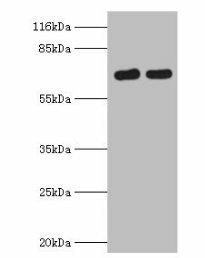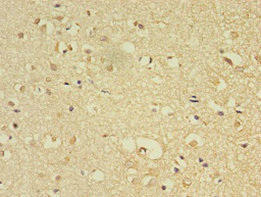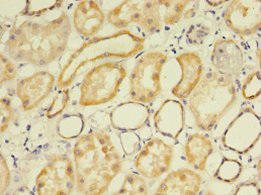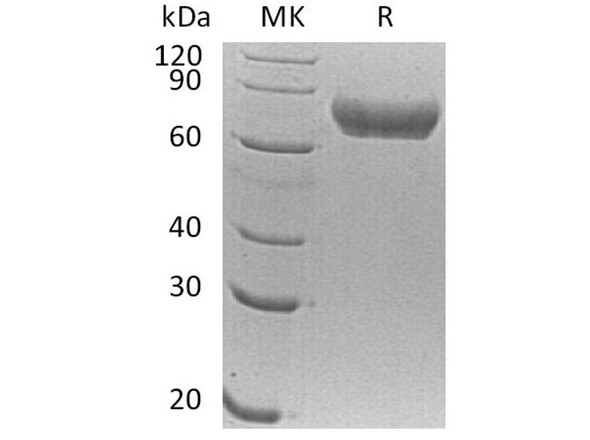Description
| Antibody Name: | FLRT1 Antibody (PACO40690) |
| Antibody SKU: | PACO40690 |
| Size: | 50ug |
| Host Species: | Rabbit |
| Tested Applications: | ELISA, WB, IHC |
| Recommended Dilutions: | ELISA:1:2000-1:10000, WB:1:500-1:2000, IHC:1:20-1:200 |
| Species Reactivity: | Human, Mouse |
| Immunogen: | Recombinant Human Leucine-rich repeat transmembrane protein FLRT1 protein (21-289AA) |
| Form: | Liquid |
| Storage Buffer: | Preservative: 0.03% Proclin 300 Constituents: 50% Glycerol, 0.01M PBS, PH 7.4 |
| Purification Method: | >95%, Protein G purified |
| Clonality: | Polyclonal |
| Isotype: | IgG |
| Conjugate: | Non-conjugated |
 | Western blot. All lanes: FLRT1 antibody at 2µg/ml. Lane 1: Mouse kidney tissue. Lane 2: Hela whole cell lysate. Secondary. Goat polyclonal to rabbit IgG at 1/10000 dilution. Predicted band size: 72 kDa. Observed band size: 72 kDa. |
 | Immunohistochemistry of paraffin-embedded human brain tissue using PACO40690 at dilution of 1:100. |
 | Immunohistochemistry of paraffin-embedded human kidney tissue using PACO40690 at dilution of 1:100. |
| Background: | May have a function in cell adhesion and/or receptor signaling. |
| Synonyms: | Leucine-rich repeat transmembrane protein FLRT1 (Fibronectin-like domain-containing leucine-rich transmembrane protein 1), FLRT1 |
| UniProt Protein Function: | FLRT1: May have a function in cell adhesion and/or receptor signaling.Protein type: Cell adhesion; Motility/polarity/chemotaxis; Membrane protein, integralChromosomal Location of Human Ortholog: 11q13.1Cellular Component: cytoplasm; cytoplasmic vesicle; cytoplasmic vesicle membrane; endoplasmic reticulum membrane; extracellular space; focal adhesion; integral to plasma membrane; intercellular junction; perinuclear region of cytoplasm; proteinaceous extracellular matrixMolecular Function: fibroblast growth factor receptor binding; protein binding, bridging; protein kinase inhibitor activity; receptor signaling protein activityBiological Process: cell adhesion; cytokine and chemokine mediated signaling pathway; dendrite development; fibroblast growth factor receptor signaling pathway; negative regulation of JAK-STAT cascade; negative regulation of protein kinase activity; positive regulation of synaptogenesis |
| UniProt Protein Details: | |
| NCBI Summary: | This gene encodes a member of the fibronectin leucine rich transmembrane protein (FLRT) family. The family members may function in cell adhesion and/or receptor signalling. Their protein structures resemble small leucine-rich proteoglycans found in the extracellular matrix. The encoded protein shares sequence similarity with two other family members, FLRT2 and FLRT3. This gene is expressed in kidney and brain. [provided by RefSeq, Jul 2008] |
| UniProt Code: | Q9NZU1 |
| NCBI GenInfo Identifier: | 34577057 |
| NCBI Gene ID: | 23769 |
| NCBI Accession: | NP_037412.2 |
| UniProt Secondary Accession: | Q9NZU1,Q8WVA2 |
| UniProt Related Accession: | Q9NZU1 |
| Molecular Weight: | |
| NCBI Full Name: | leucine-rich repeat transmembrane protein FLRT1 |
| NCBI Synonym Full Names: | fibronectin leucine rich transmembrane protein 1 |
| NCBI Official Symbol: | FLRT1 |
| NCBI Official Synonym Symbols: | SPG68 |
| NCBI Protein Information: | leucine-rich repeat transmembrane protein FLRT1 |
| UniProt Protein Name: | Leucine-rich repeat transmembrane protein FLRT1 |
| UniProt Synonym Protein Names: | Fibronectin-like domain-containing leucine-rich transmembrane protein 1 |
| Protein Family: | Leucine-rich repeat transmembrane protein |
| UniProt Gene Name: | FLRT1 |
| UniProt Entry Name: | FLRT1_HUMAN |






